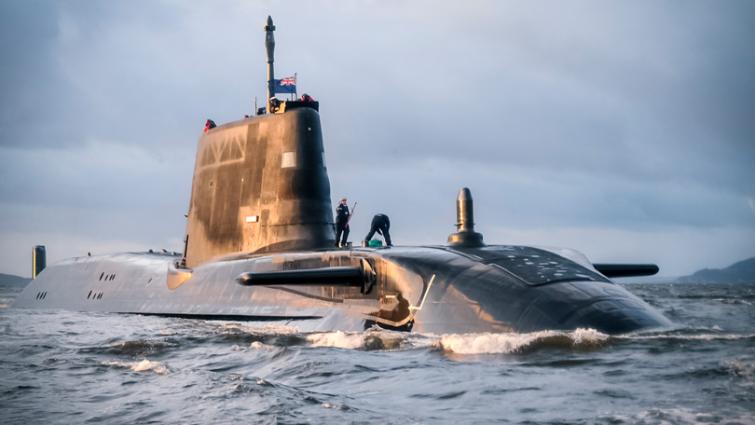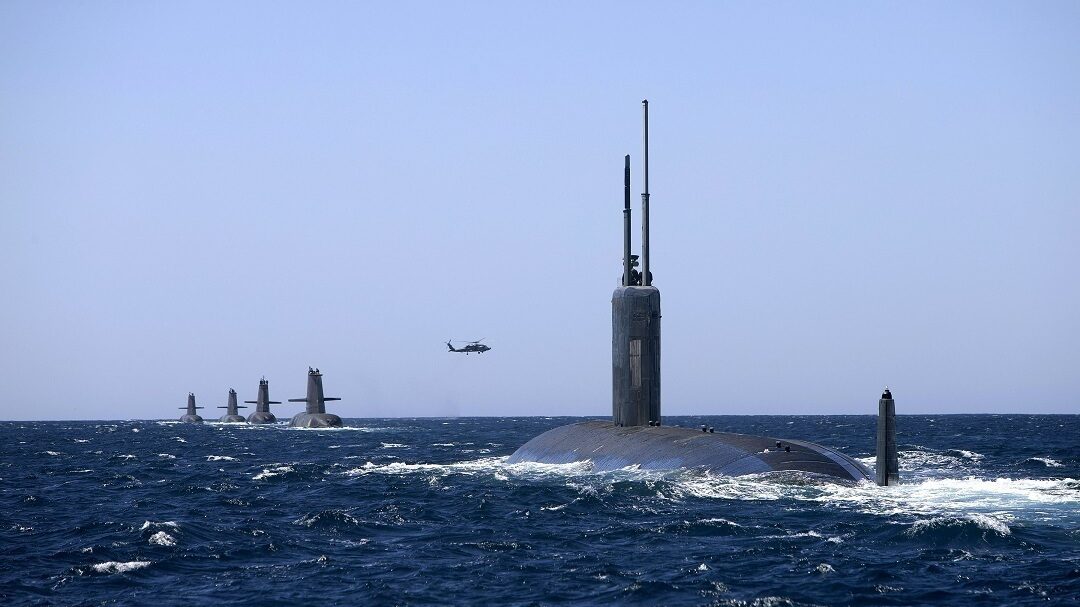
Astute class nuclear powered attack submarine Credit: Royal Navy
SYDNEY — One year after the surprise announcement of the AUKUS security arrangement, the Australian navy faces “high risks” as it grapples with construction of an expanded and more powerful navy, including nuclear attack submarines that are the centerpiece of the agreement between Australia, the United Kingdom and the United States.
“The complex transition to the future maritime force involves high risks, especially in workforce growth, industry capacity, domestic and international supply chains, infrastructure lead times, and the overall affordability of the maritime program,” said a recent report.
That assessment, covering major military issues, does not come from a grumbling critic of the nuclear program, an esteemed expert at a think tank or university, but from the government itself in a briefing provided to incoming Defense Minister Richard Marles. The heavily redacted briefing was provided to The Australian’s defense reporter, Ben Packham, as a result of a Freedom of Information request, and was published on Sept. 9.
The submarine program appears to be a central factor in that assessment. While the briefing estimates that Australia will spend $120 billion AUD (about $81.2 billion USD) through the next decade as it expands its maritime force projection capabilities to cope with an increasingly hegemonist China, the briefing notes that “this estimate does not include the additional costs that may be required for the nuclear-powered submarine capability.”
There aren’t any official estimates yet for the costs of the nuclear-powered attack sub program, and in the year since the Sept. 15 agreement (Sept. 16 in Australia), one of the few detailed estimates of the costs to build an eight-boat nuclear attack fleet came from a December Australian Strategic Policy Institute study that puts the costs at “around $70 billion [AUD] constant (or $116 billion in out-turned dollars, which account for inflation).”
The sub purchases are a unique commitment by Australia to enter the rarefied ranks of countries who sail nuclear–powered submarines: China, France, India, Russia, the UK and the US.
But the risk to Australia’s maritime investments does not flow only from the new subs. As the briefing says, “all of our frigates and destroyers will be modernised this decade to maintain combat relevance in the region; all six Collins class submarines will have their operating life extended (starting in 2026) and their capabilities improved.” The life extension of the Collins class subs “will underpin transition to the nuclear-powered submarines in the late 2030s…”
The late 2030s date is significant in that many experts in and out of government here doubt whether the nuclear-powered subs can be built in time to avoid a capability gap when the ageing Collins class boats finally kick the bucket. Marles has said determining if there is a gap and what to do about it is his top priority.
“The key strategic risk remains we might need the SSNs much earlier than the proposed schedule,” Neil James, executive director of the non-partisan watchdog, the Australia Defence Association, said in an email. “In turn, this may require Australia helping fund increased production capacity overseas to achieve some boats earlier — but at substantially increased overall cost and delays to local construction capacity (with domestic political costs). Increasing the submariner training pipeline will also require substantial USN and RN co-operation.”
The challenges are many. The AUKUS boats require Australia to build an entire nuclear infrastructure, including educating enough civilians and unformed personnel with technical knowledge to both build and maintain the boats, and to write policy and to meet UN nuclear safeguards standards.
The Australian Nuclear Science and Technology Organization is tasked with developing the policies and guidelines to ensure the country, which has very little nuclear energy experience and was actually legally barred construction of nuclear plants 24 years ago, can comply with International Atomic Energy Agency requirements. That means ANTSO must expand substantially to account for the nuclear submarine program, experts here agree.
Working On A ‘Workforce Strategy’
Parallel to that, the government brief acknowledges that “[o]wning and operating nuclear-powered submarines will require substantial development of Australia’s workforce.” At the strategic level, that means recruiting thousands of new civilian and military personnel, training them and creating the highly technical security infrastructure to secure both personnel and nuclear materials. The Defense Ministry is developing a “workforce strategy” for the government to examine and is “also developing a strategy to grow scientific and engineering capability and capacity in Australia to support the nuclear-powered submarines throughout their life.”
This effort is so new that the military has just begun over the last six months to work with universities and other training institutions to make sure Australian sailors and civilians will get the required skills and qualifications.

Los Angeles class USS Santa Fe (SSN 763) joins Royal Australian Navy Collins Class Submarines HMAS Collins, HMAS Farncomb, HMAS Dechaineux and HMAS Sheean in the West Australian Exercise Area in February 2019. Credit: RAN LSIS Richard Cordell
The brief says “scholarships have been offered to Defence personnel […] to study for a Masters of Nuclear Science at the Australian National University or a Masters of Nuclear Engineering at the University of New South Wales as well as broader untied scholarships to encourage general take up of nuclear pathways.”
And Britain announced last month that Aussie bubbleheads will train on British nuclear-powered Astute class submarines for the first time. First, they must complete nuclear training courses. Then they will embark on HMS Anson, the newest of the Astute class. Marles attended her Sept. 1 commissioning in Barrow, northern England.
Buying Class: What Kind Of Nuclear Subs Will There Be?
Where the subs will be built is still being hammered out. The Nuclear-Powered Submarine Taskforce has, the briefing says, “conducted a feasibility study of Osborne North in South Australia as the site to build Australia’s nuclear-powered submarines and is further examining what land would be required and how to make this land fit for purpose.”
A bigger question also remains unresolved: What class of submarine will Australia build?Will it be a variant of the British Astute class or of its successor, the Dreadnought class, (formerly known lyrically as the Submersible Ship Nuclear Replacement). Or might it be based on the American Virginia class boats, or the more advanced Columbia class? Might it be a blend of one country’s hull design with another’s reactor?
The briefing doesn’t say, but one thing two industry experts and one academic here told Breaking Defense is that the Australian boat is very likely to use Lockheed Martin’s combat system. That’s what was to be installed on the Australia-destined French subs that were discarded in favor of the nuclear option, so the Australian Royal Navy appears comfortable with buying the system.
But Australia is not the only country facing risks in this effort. The top uniformed American sub builder, Rear Adm. Scott Pappano, warned of the impact of additional sub construction sparked by the AUKUS agreement on both his country and the United Kingdom, should some of the weight of the new construction fall on their shoulders.
“If you are asking my opinion, if we were going to add additional submarine construction to our industrial base, that would be detrimental to us right now, without significant investment to provide additional capacity, capability to go do that,” Pappano told the Mitchell Institute in Washington. “I won’t speak for the UK, but I think that exists for both the US and the UK where we’re looking right now.”
So, many decisions to come, many risks to manage. The first chop will occur in March, when Marles has said Australia will announce which sub it will build. The ministry brief says that process was on schedule. The cascade of billion-dollar choices the newest entrant to the nuclear sub club will only grow broader and faster after Marles makes that fateful choice.






















